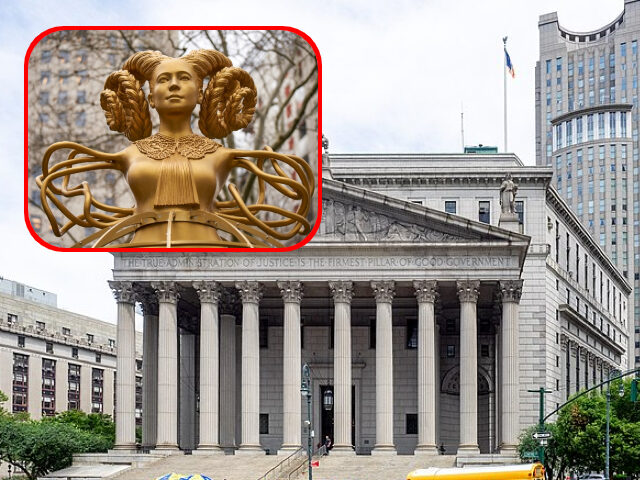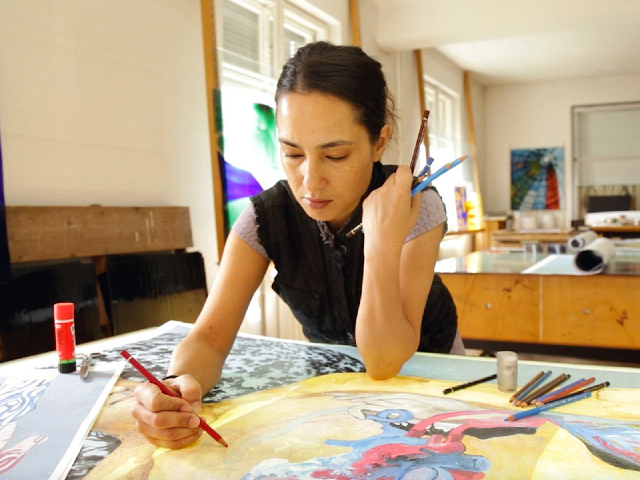A statue of a horned feminine figure emerging out of a lotus, supposedly symbolizing “femininity” and paying homage to the late Supreme Court Justice Ruth Bader Ginsburg, who fought for abortion, now sits atop the New York City courthouse.
The artist, Shahzia Sikander, created the statue “NOW,” which sits on top of the courthouse alongside other statues representing lawmakers throughout history. The statue itself appears as the body of a woman emerging from a lotus, which is often associated with the pagan Egyptian god Nefertem as well as the Hindu gods Vishnu and Brahma.
It also features Ginsburg’s well-recognized laced collar — a “nod” to the late-Justice, according to the artist — which sits below the figure’s braided horns, which the artist herself affirmed are, in fact, horns.
“The lotus, with its plethora of meanings and abstract ideas, is symbolic of a deeper truth beyond its form, alluding to perception as illusion. Popular in images in many cultures, it also expresses intangible ideas of humility, awakening, and clarity,” she claimed in the artist notes.
“The female body has a face with its hair braided into spiraling ‘horns.’ The horns mimic the movement of the arms and are there as a symbol of the figure’s sovereignty, and its autonomy. Women in my work are always complex, proactive, confident, intelligent and in their playful stances connected to the past in imaginative ways without being tied to a heteronormative lineage or conventional representations of diaspora and nation,” she continued, explaining that “femininity to me is the tension between women and power. “
Sikander also detailed the influence of the Supreme Court decision saving the lives of countless unborn children in overturning Roe v. Wade, claiming that the fight for “equality” continues. She added that Ginsburg’s death and subsequent overturning of Roe served as a setback for women, despite the fact that the Supreme Court’s ruling itself did not outlaw abortion but, rather, sent the decisions back to individual states.
The New York Times touted the statue this way: “Move Over Moses and Zoroaster: Manhattan Has a New Female Lawgiver.”
Other figures on the courthouse’s roof represent legal systems and faiths from elsewhere across the world.
A new statue atop a New York City courthouse. The artist says it’s part of an “urgent and necessary cultural reckoning underway as New York reconsiders traditional representations of power in public spaces and recasts civic structures to better reflect 21st-century social mores.” pic.twitter.com/4IFRj7hCsf
— Andrew Beck (@AndrewBeckUSA) January 25, 2023
BREAKING: New statue named "NOW" depicting female figure placed upon roof of New York City courthouse to pay homage to Ruth Bader Ginsberg and her fight for abortion. pic.twitter.com/VsqtWsE1id
— Upward News (@UpwardNewsHQ) January 25, 2023
A sexless lovecraftian monster with horn hair and tentacle arms. What's not to like? https://t.co/QkhUxxgG4y
— Noam Blum (@neontaster) January 25, 2023
This is hardly the first instance of pagan imagery featured outside of prominent locations across the country and world. The European Organization for Nuclear Research, CERN, for instance, has a statue of Shiva, the Hindu goddess of destruction, outside of its facility.
Americans may be more familiar with the infamous statue of Baphomet, unveiled in Detroit in 2015. The satanic figure features a prominent pentagram and is flanked by two young children. Years later, the statue made an appearance at the Arkansas Capitol building:


COMMENTS
Please let us know if you're having issues with commenting.